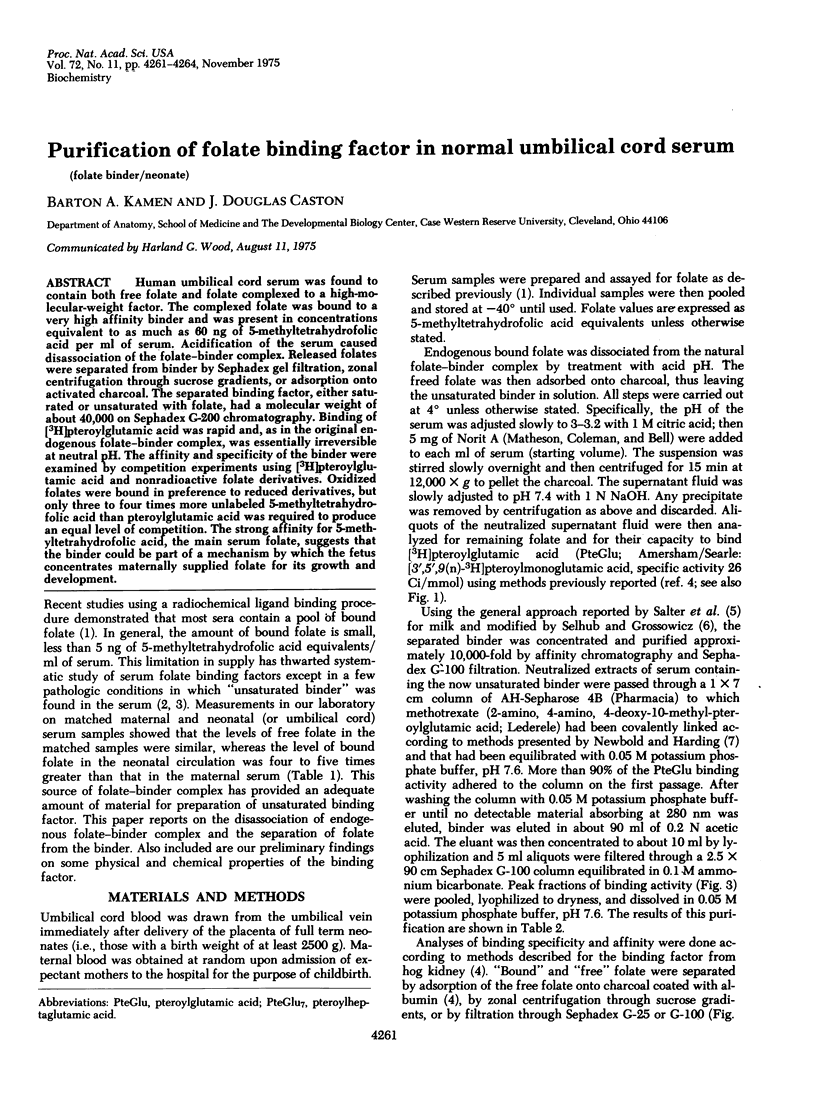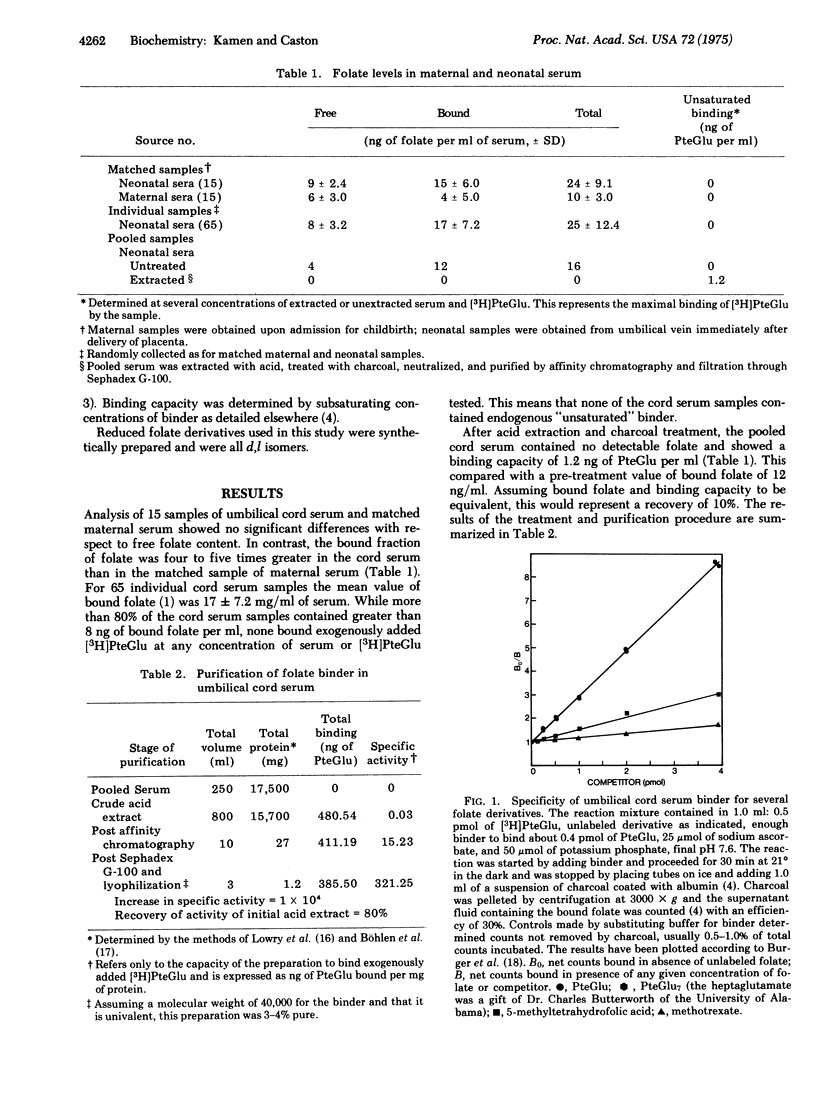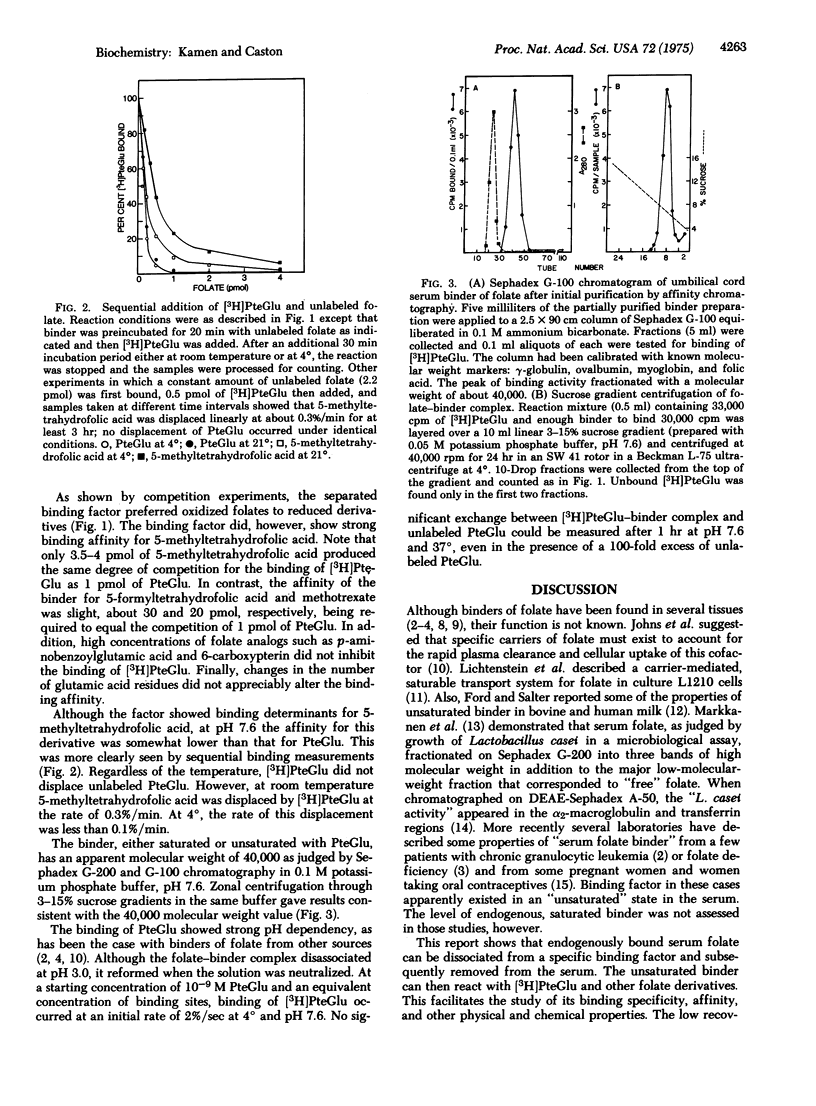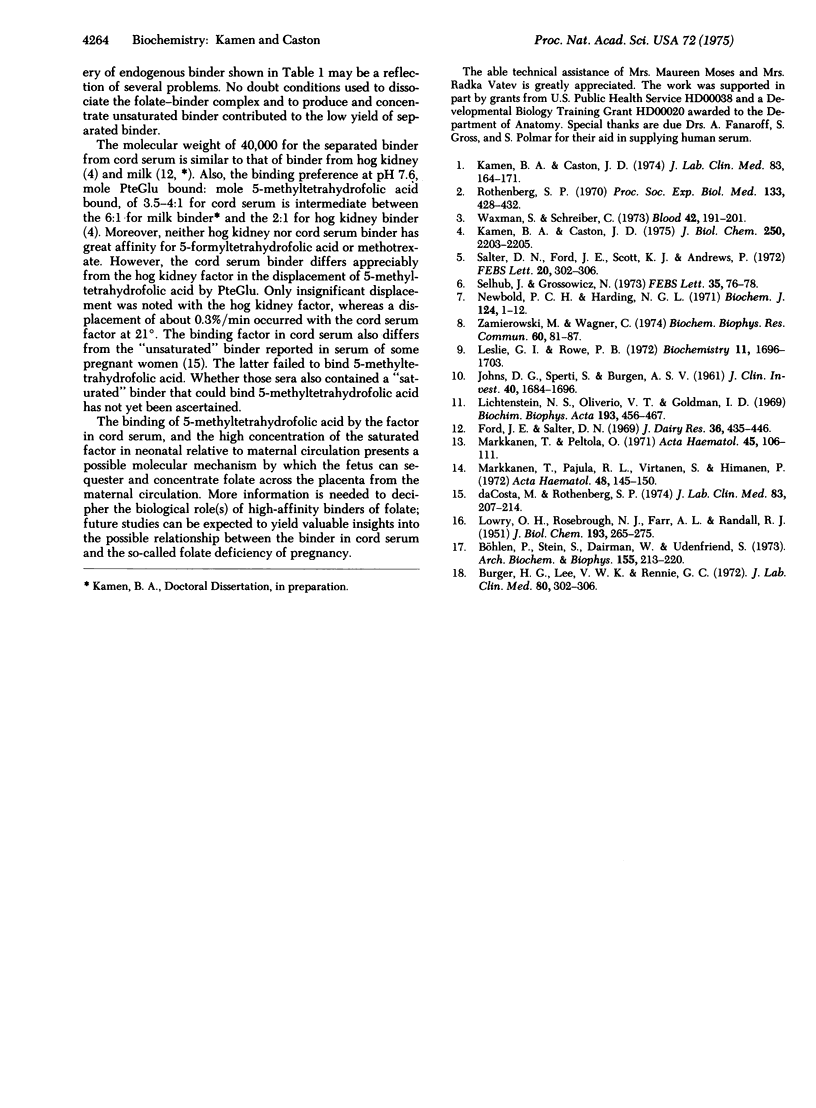Abstract
Human umbilical cord serum was found to contain both free folate and folate complexed to a high-molecular weight factor. The complexed folate was bound to a very high affinity binder and was present in concentrations equivalent to as much as 60 ng of 5-methyltetrahydrofolic acid per ml of serum. Acidification of the serum caused disassociation of the folate-binder complex. Released folates were separated from binder by Sephadex gel filtration, zonal centrifugation through sucrose gradients, or adsorption onto activated charcoal. The separated binding factor, either saturated or unsaturated with folate, had a molecular weight of about 40,000 on Sephadex G-200 chromatography. Binding of [3H]pteroylglutamic acid was rapid and, as in the original endogenous folate-binder complex, was essentially irreversible at neutral pH. The affinity and specificity of the binder were examined by competition experiments using [3H]pteroylglutamic acid and nonradioactive folate derivatives. Oxidized folates were bound in preference to reduced derivatives, but only three to four times more unlabeled 5-methyltetrahydrofolic acid than pteroylglutamic acid was required to produce an equal level of competition. The strong affinity for 5-methyltetrahydrofolic acid, the main serum folate, suggests that the binder could be part of the mechanism by which the fetus concentrates maternally supplied folate for its growth and development.
Full text
PDF



Selected References
These references are in PubMed. This may not be the complete list of references from this article.
- Burger H. G., Lee V. W., Rennie G. C. A generalized computer program for the treatment of data from competitive protein-binding assays including radioimmunoassays. J Lab Clin Med. 1972 Aug;80(2):302–312. [PubMed] [Google Scholar]
- Böhlen P., Stein S., Dairman W., Udenfriend S. Fluorometric assay of proteins in the nanogram range. Arch Biochem Biophys. 1973 Mar;155(1):213–220. doi: 10.1016/s0003-9861(73)80023-2. [DOI] [PubMed] [Google Scholar]
- Da Costa M., Rothenberg S. P. Appearance of a folate binder in leukocytes and serum of women who are pregnant or taking oral contraceptives. J Lab Clin Med. 1974 Feb;83(2):207–214. [PubMed] [Google Scholar]
- JOHNS D. G., SPERTI S., BURGEN A. S. The metabolism of tritiated folic acid in man. J Clin Invest. 1961 Sep;40:1684–1695. doi: 10.1172/JCI104391. [DOI] [PMC free article] [PubMed] [Google Scholar]
- Kamen B. A., Caston J. D. Direct radiochemical assay for serum folate: competition between 3H-folic acid and 5-methyltetrahydrofolic acid for a folate binder. J Lab Clin Med. 1974 Jan;83(1):164–174. [PubMed] [Google Scholar]
- Kamen B. A., Caston J. D. Identification of a folate binder in hog kidney. J Biol Chem. 1975 Mar 25;250(6):2203–2205. [PubMed] [Google Scholar]
- LOWRY O. H., ROSEBROUGH N. J., FARR A. L., RANDALL R. J. Protein measurement with the Folin phenol reagent. J Biol Chem. 1951 Nov;193(1):265–275. [PubMed] [Google Scholar]
- Leslie G. I., Rowe P. B. Folate binding by the brush border membrane proteins of small intestinal epithelial cells. Biochemistry. 1972 Apr 25;11(9):1696–1703. doi: 10.1021/bi00759a026. [DOI] [PubMed] [Google Scholar]
- Lichtenstein N. S., Oliverio V. T., Goldman I. D. Characteristics of folic acid transport in the L1210 leukemia cell. Biochim Biophys Acta. 1969;193(2):456–467. doi: 10.1016/0005-2736(69)90204-1. [DOI] [PubMed] [Google Scholar]
- Markkanen T., Pajula R. L., Virtanen S., Himanen P. New carrier protein(s) of folic acid in human serum. Acta Haematol. 1972;48(3):145–150. doi: 10.1159/000208450. [DOI] [PubMed] [Google Scholar]
- Markkanen T., Peltola O. Carrier proteins of folic acid activity in human serum. Acta Haematol. 1971;45(2):106–111. doi: 10.1159/000208613. [DOI] [PubMed] [Google Scholar]
- Newbold P. C., Harding N. G. Affinity chromatography of dihydrofolate reductase. Biochem J. 1971 Aug;124(1):1–12. doi: 10.1042/bj1240001. [DOI] [PMC free article] [PubMed] [Google Scholar]
- Rothenberg S. P. A macromolecular factor in some leukemic cells which binds folic acid. Proc Soc Exp Biol Med. 1970 Feb;133(2):428–432. doi: 10.3181/00379727-133-34489. [DOI] [PubMed] [Google Scholar]
- Salter D. N., Ford J. E., Scott K. J., Andrews P. Isolation of the folate-binding protein from cow's milk by the use of affinity chromatography. FEBS Lett. 1972 Feb 15;20(3):302–306. doi: 10.1016/0014-5793(72)80092-9. [DOI] [PubMed] [Google Scholar]
- Selhub J., Grossowicz N. Chemical fixation of folate binding protein to activated sepharose. FEBS Lett. 1973 Sep 1;35(1):76–78. doi: 10.1016/0014-5793(73)80580-0. [DOI] [PubMed] [Google Scholar]
- Zamierowski M., Wagner C. High molecular weight complexes of folic acid in mammalian tissues. Biochem Biophys Res Commun. 1974 Sep 9;60(1):81–87. doi: 10.1016/0006-291x(74)90175-2. [DOI] [PubMed] [Google Scholar]


